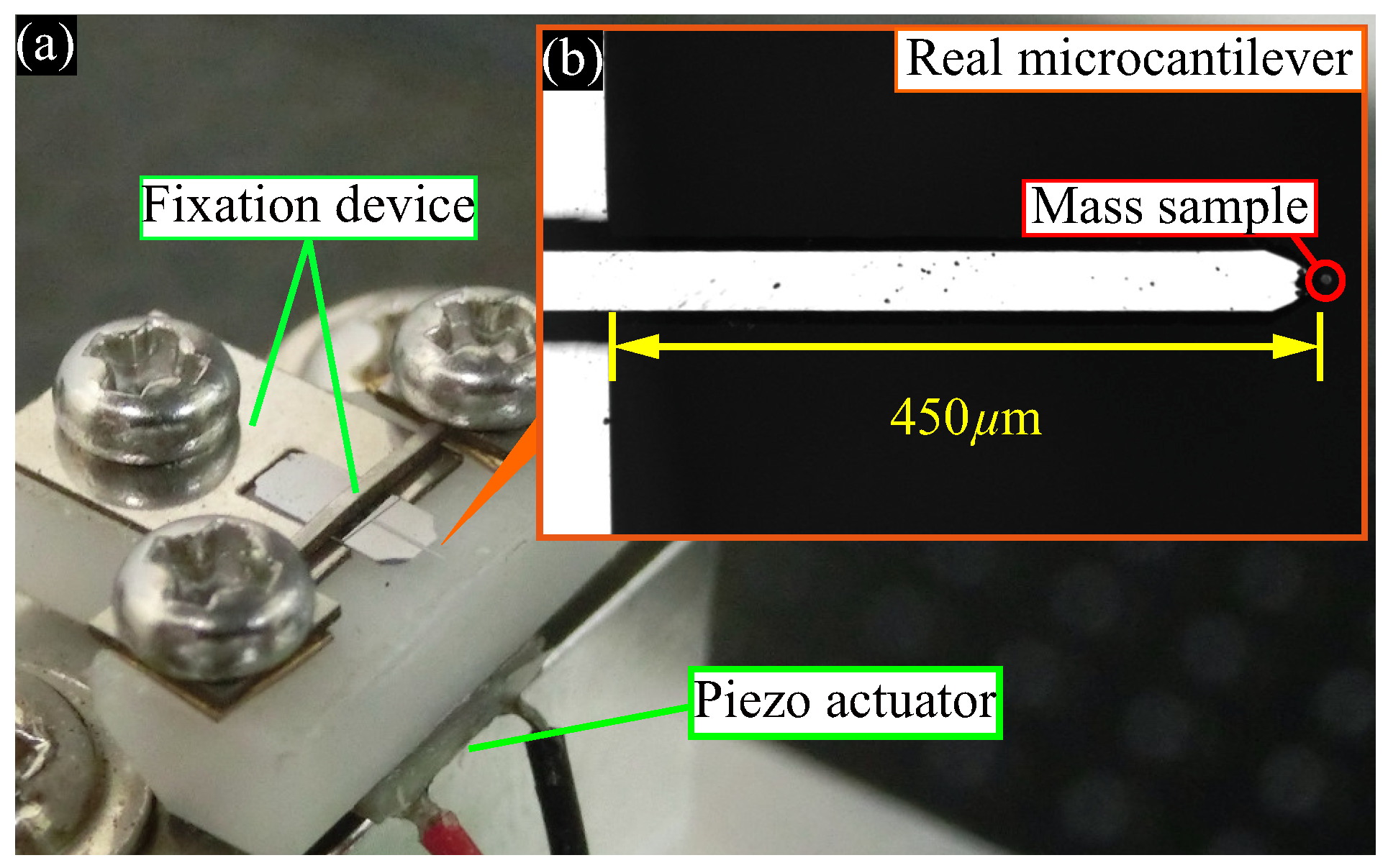Ultra-Sensitive Minute Mass Sensing Using a Microcantilever Virtually Coupled with a Virtual Cantilever
Abstract
:1. Introduction
2. Theory
2.1. Analytical Model of Weakly Coupled Cantilevers
2.2. Mass Measurement Method Using Self-Excited Weakly Coupled Cantilevers
2.3. Implementation of a Virtual Coupling between a Real Microcantilever and a Virtual Cantilever
3. Experiment
3.1. Experimental Setup
3.2. Experimental Results
3.2.1. Identity of Real and Virtual Cantilevers
3.2.2. Coupling Ratio
3.2.3. Mass Measurement
4. Conclusions
Author Contributions
Funding
Conflicts of Interest
References
- Spletzer, M.; Raman, A.; Sumali, H.; Sullivan, J.P. Highly sensitive mass detection and identification using vibration localization in coupled microcantilever arrays. Appl. Phys. Lett. 2008, 92, 114102. [Google Scholar] [CrossRef] [Green Version]
- Mouro, J.; Tiribilli, B.; Paoletti, P. Measuring viscosity with nonlinear self-excited microcantilevers. Appl. Phys. Lett. 2017, 111, 144101. [Google Scholar] [CrossRef] [Green Version]
- Okajima, T.; Sekiguchi, H.; Arakawa, H.; Ikai, A. Self-oscillation technique for AFM in liquids. Appl. Surf. Sci. 2003, 210, 68–72. [Google Scholar] [CrossRef]
- Basso, M.; Paoletti, P.; Tiribilli, B.; Vassalli, M. AFM imaging via nonlinear control of self-driven cantilever oscillations. IEEE. Trans. Nanotechnol. 2011, 10, 560–565. [Google Scholar] [CrossRef]
- Seshia, A.A.; Palaniapan, M.; Roessig, T.A.; Howe, R.T.; Gooch, R.W.; Schimert, T.R.; Montague, S. A vacuum packaged surface micromachined resonant accelerometer. J. Microelectromech. Syst. 2002, 11, 784–793. [Google Scholar] [CrossRef] [Green Version]
- Jin, D.; Li, X.; Liu, J.; Zuo, G.; Wang, Y.; Liu, M.; Yu, H. High-mode resonant piezoresistive cantilever sensors for tens-femtogram resoluble mass sensing in air. J. Micromech. Microeng. 2006, 16, 1017. [Google Scholar] [CrossRef]
- Spletzer, M.; Raman, A.; Wu, A.Q.; Xu, X.; Reifenberger, R. Ultrasensitive mass sensing using mode localization in coupled microcantilevers. Appl. Phys. Lett. 2006, 88, 254102. [Google Scholar] [CrossRef] [Green Version]
- Ono, T.; Li, X.; Miyashita, H.; Esashi, M. Mass sensing of adsorbed molecules in sub-picogram sample with ultrathin silicon resonator. Rev. Sci. Instrum. 2003, 74, 1240–1243. [Google Scholar] [CrossRef]
- Ono, T.; Esashi, M. Mass sensing with resonating ultra-thin silicon beams detected by a double-beam laser Doppler vibrometer. Meas. Sci. Technol. 2004, 15, 1977. [Google Scholar] [CrossRef]
- Gupta, A.; Akin, D.; Bashir, R. Single virus particle mass detection using microresonators with nanoscale thickness. Appl. Phys. Lett. 2004, 84, 1976–1978. [Google Scholar] [CrossRef]
- Yabuno, H.; Seo, Y.; Kuroda, M. Self-excited coupled cantilevers for mass sensing in viscous measurement environments. Appl. Phys. Lett. 2013, 103, 063104. [Google Scholar] [CrossRef]
- Endo, D.; Yabuno, H.; Higashino, K.; Yamamoto, Y.; Matsumoto, S. Self-excited coupled-microcantilevers for mass sensing. Appl. Phys. Lett. 2015, 106, 223105. [Google Scholar] [CrossRef] [Green Version]
- Endo, D.; Yabuno, H.; Yamamoto, Y.; Matsumoto, S. Mass Sensing in a Liquid Environment Using Nonlinear Self-Excited Coupled-Microcantilevers. J. Microelectromech. Syst. 2018, 27, 774–779. [Google Scholar] [CrossRef]
- Lin, Y.; Yabuno, H.; Liu, X.; Yamamoto, Y.; Matsumoto, S. Highly sensitive AFM using self-excited weakly coupled cantilevers. Appl. Phys. Lett. 2019, 115, 133105. [Google Scholar] [CrossRef]
- Zhang, H.; Li, B.; Yuan, W.; Kraft, M.; Chang, H. An acceleration sensing method based on the mode localization of weakly coupled resonators. J. Microelectromech. Syst. 2016, 25, 286–296. [Google Scholar] [CrossRef]
- Okamoto, H.; Kitajima, N.; Onomitsu, K.; Kometani, R.; Warisawa, S.-i.; Ishihara, S.; Yamaguchi, H. High-sensitivity charge detection using antisymmetric vibration in coupled micromechanical oscillators. Appl. Phys. Lett. 2011, 98, 014103. [Google Scholar] [CrossRef]
- Thiruvenkatanathan, P.; Yan, J.; Woodhouse, J.; Aziz, A.; Seshia, A. Ultrasensitive mode-localized mass sensor with electrically tunable parametric sensitivity. Appl. Phys. Lett. 2010, 96, 081913. [Google Scholar] [CrossRef] [Green Version]
- Manav, M.; Phani, A.S.; Cretu, E. Mode localized MEMS transducers with voltage-controlled linear coupling. J. Micromech. Microeng. 2017, 27, 055010. [Google Scholar] [CrossRef]
- Manav, M.; Reynen, G.; Sharma, M.; Cretu, E.; Phani, A. Ultrasensitive resonant MEMS transducers with tuneable coupling. J. Micromech. Microeng. 2014, 24, 055005. [Google Scholar] [CrossRef]
- Kasai, Y.; Yabuno, H.; Ishine, T.; Yamamoto, Y.; Matsumoto, S. Mass sensing using a virtual cantilever virtually coupled with a real cantilever. Appl. Phys. Lett. 2019, 115, 063103. [Google Scholar] [CrossRef]
Sample Availability: The data that support the findings of this study are openly available in figshare at http://doi.org/10.6084/m9.figshare.11859435. |







© 2020 by the authors. Licensee MDPI, Basel, Switzerland. This article is an open access article distributed under the terms and conditions of the Creative Commons Attribution (CC BY) license (http://creativecommons.org/licenses/by/4.0/).
Share and Cite
Kasai, Y.; Yabuno, H.; Yamamoto, Y.; Matsumoto, S. Ultra-Sensitive Minute Mass Sensing Using a Microcantilever Virtually Coupled with a Virtual Cantilever. Sensors 2020, 20, 1823. https://doi.org/10.3390/s20071823
Kasai Y, Yabuno H, Yamamoto Y, Matsumoto S. Ultra-Sensitive Minute Mass Sensing Using a Microcantilever Virtually Coupled with a Virtual Cantilever. Sensors. 2020; 20(7):1823. https://doi.org/10.3390/s20071823
Chicago/Turabian StyleKasai, Yuki, Hiroshi Yabuno, Yasuyuki Yamamoto, and Sohei Matsumoto. 2020. "Ultra-Sensitive Minute Mass Sensing Using a Microcantilever Virtually Coupled with a Virtual Cantilever" Sensors 20, no. 7: 1823. https://doi.org/10.3390/s20071823




